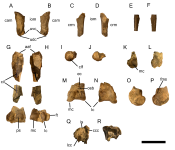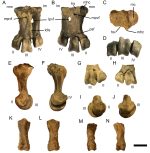albertonykus
Well-known member
Xia, B.-Y., J.-L. Pei, and Q.-G. Li (2024)
A new penguin fossil from Seymour Island and reassessment of taxonomy and diversity of Eocene Antarctic penguins
Palaeoworld (advance online publication)
doi: 10.1016/j.palwor.2024.04.007
Eocene penguins from Seymour Island play an important role in studies related to the taxonomy and evolution of the Sphenisciformes stem group. Among these penguins, the Palaeeudyptes species are particularly noteworthy for their unusually large size and the contentious nature of their classification criteria. In this study, we describe a new penguin skeleton with a well-preserved tarsometatarsus discovered in the Upper Eocene of Seymour Island, Antarctica. The new fossil exhibits tarsometatarsal characteristics of Palaeeudyptes but differs from two species of Palaeeudyptes previously found on Seymour Island, providing insights on the morphological diversity and evolutionary history of early penguins. We conduct normality and unimodality tests on Palaeeudyptes taxa from Seymour Island to reassess the hypothesis that size differences between the two species of this genus could be attributed to sexual dimorphism in a single species. The results revealed that size differences are unlikely due to sexual dimorphism. We also use the linear discriminant analysis to evaluate the taxonomic criteria for the two Palaeeudyptes species discovered in the Antarctic region. The data showed an overlap in the size distribution, indicating weakness in the classification criteria. Reassessing previous samples and establishing an additional diagnosis based on critical anatomical features could potentially resolve this issue.
A new penguin fossil from Seymour Island and reassessment of taxonomy and diversity of Eocene Antarctic penguins
Palaeoworld (advance online publication)
doi: 10.1016/j.palwor.2024.04.007
Eocene penguins from Seymour Island play an important role in studies related to the taxonomy and evolution of the Sphenisciformes stem group. Among these penguins, the Palaeeudyptes species are particularly noteworthy for their unusually large size and the contentious nature of their classification criteria. In this study, we describe a new penguin skeleton with a well-preserved tarsometatarsus discovered in the Upper Eocene of Seymour Island, Antarctica. The new fossil exhibits tarsometatarsal characteristics of Palaeeudyptes but differs from two species of Palaeeudyptes previously found on Seymour Island, providing insights on the morphological diversity and evolutionary history of early penguins. We conduct normality and unimodality tests on Palaeeudyptes taxa from Seymour Island to reassess the hypothesis that size differences between the two species of this genus could be attributed to sexual dimorphism in a single species. The results revealed that size differences are unlikely due to sexual dimorphism. We also use the linear discriminant analysis to evaluate the taxonomic criteria for the two Palaeeudyptes species discovered in the Antarctic region. The data showed an overlap in the size distribution, indicating weakness in the classification criteria. Reassessing previous samples and establishing an additional diagnosis based on critical anatomical features could potentially resolve this issue.







